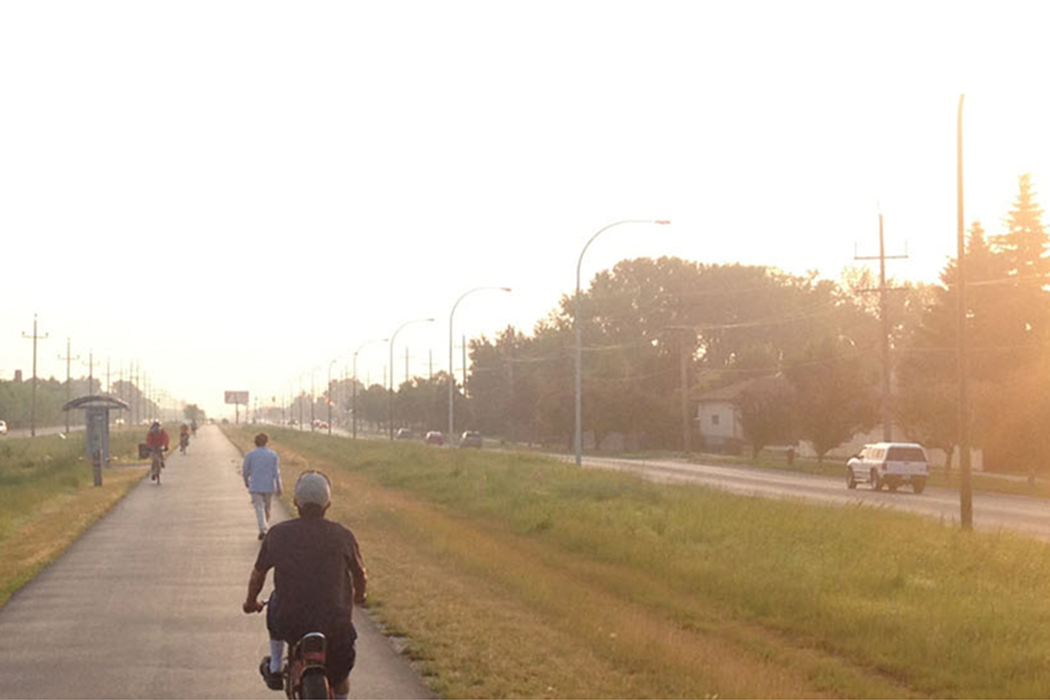
The Northeast Pioneers Greenway is one of the four multi-use trails in Winnipeg that was studied in the research project. (Photo courtesy of Winnipeg Trails Association)
UM study finds living near trails reduces risk for heart disease
A University of Manitoba-led study found that living close to a trail used for walking, running and cycling leads to an eight per cent reduction in the risk factors for heart disease.
“If you build it, they will come, and maybe even live longer,” said Dr. Jon McGavock, professor of pediatrics and child health at the Max Rady College of Medicine, Rady Faculty of Health Sciences.
The study looked at four multi-use trails in Winnipeg – the Yellow Ribbon Greenway, Northeast Pioneers Greenway, Transcona Trail and Southside Greenway. The trails ranged from four to seven kilometres and are in largely suburban areas.
The study, published in the International Journal of Behavioral Nutrition and Physical Activity, found that the 20 kilometres of trails attracted 5,000 cyclists every week. This added up to 1.6 million cycling trips over a five-year period.
“Since the trails were built in 2012, that adds up to 4,000 to 7,000 fewer Winnipeggers living with a risk factor for heart disease,” said McGavock, who is also an investigator with the Children’s Hospital Research Institute of Manitoba. “Importantly, this health benefit was greatest for people living along the Southside Greenway, the busiest trail.”
The study, supported by the Heart and Stroke Foundation of Canada, found that the construction of the four paved, multi-use trails affected about 48,000 people living within 400 meters of a trail, McGavock said. He said the data shows that expanding multi-use trails may reduce risk factors for heart disease in areas next to a trail, but this effect was sensitive to frequency of trail use, or trail characteristics.
McGavock and his team, that included associate professor of pediatrics and child health Dr. Kelly Russell, partnered with the City of Winnipeg and the Winnipeg Trails Association. A critical collaboration was also with the Manitoba Centre for Health Policy’s Charles Burchill, associate director, repository, data access and use, and Heather Prior, lead data analyst.
Anders Swanson, executive director of Winnipeg Trails Association, said that what’s important about this research is the link it establishes between the busiest of the trails and heart health.
“Clearly, it is not enough to have a trail, it must be useful, nearby and part of a continuous network,” Swanson said. “Any given trail must also connect to the places where people need to go. When it does, it gets busier. The busier it is, and the more it connects to a mixture of uses, the more impactful it is in terms of cardiovascular disease.”
This is the largest experiment to date examining the impact of changes to the built environment that facilitate physical activity – like multi-use trails – on cardiovascular disease-related events and risk factors. McGavock said his study is significant because despite the rapid expansion of multi-use trails in many cities there are few studies looking at their impact on the health of the people that use them.
“Winnipeg Trails would like to acknowledge all of the participants who took the time to be surveyed out on the trail and the research staff who carried out the study, but especially the late Danielle Moore, a friend and a colleague with a passion for science who would have been very proud,” Swanson said.






